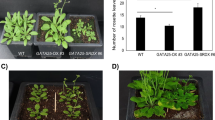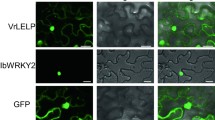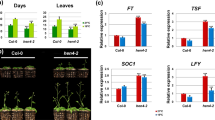Abstract
The transition from vegetative to reproductive growth phase is a pivotal and complicated process in the life cycle of flowering plants which requires a comprehensive response to multiple environmental aspects and endogenous signals. In Arabidopsis, six regulatory flowering time pathways have been defined by their response to distinct cues, namely photoperiod, vernalization, gibberellin, temperature, autonomous and age pathways, respectively. Among these pathways, the autonomous flowering pathway accelerates flowering independently of day length by inhibiting the central flowering repressor FLC. FCA, FLD, FLK, FPA, FVE, FY and LD have been widely known to play crucial roles in this pathway. Recently, AGL28, CK2, DBP1, DRM1, DRM2, ESD4, HDA5, HDA6, PCFS4, PEP, PP2A-B’γ, PRMT5, PRMT10, PRP39-1, REF6, and SYP22 have also been shown to be involved in the autonomous flowering time pathway. This review mainly focuses on FLC RNA processing, chromatin modification of FLC, post-translational modification of FLC and other molecular mechanisms in the autonomous flowering pathway of Arabidopsis.


Similar content being viewed by others
References
Abou-Elwafa SF, Büttner B, Chia T, Schulze-Buxloh G, Hohmann U, Mutasa-Göttgens E, Jung C, Müller AE (2011) Conservation and divergence of autonomous pathway genes in the flowering regulatory network of Beta vulgaris. J Exp Bot 62:3359–3374
Amasino R (2004) Take a cold flower. Nat Genet 36:111–112
Aukerman MJ, Lee I, Weigel D, Amasino RM (1999) The Arabidopsis flowering-time gene LUMINIDEPENDENS is expressed primarily in regions of cell proliferation and encodes a nuclear protein that regulates LEAFY expression. Plant J 18:195–203
Ausin I, Alonso-Blanco C, Jarillo JA, Ruiz-Garcia L, Martinez-Zapater JM (2004) Regulation of flowering time by FVE, a retinoblastoma-associated protein. Nat Genet 36:162–166
Bäurle I, Dean C (2008) Differential interactions of the autonomous pathway RRM proteins and chromatin regulators in the silencing of Arabidopsis targets. PLoS ONE 3:e2733
Bäurle I, Smith L, Baulcombe DC, Dean C (2007) Widespread role for the flowering-time regulators FCA and FPA in RNA-mediated chromatin silencing. Science 318:109–112
Blázquez M, Koornneef M, Putterill J (2001) Flowering on time: genes that regulate the floral transition. Workshop on the molecular basis of flowering time control. EMBO Rep 2:1078–1082
Boss PK, Bastow RM, Mylne JS, Dean C (2004) Multiple pathways in the decision to flower: enabling, promoting, and resetting. Plant Cell 16:S18–S31
Carrasco JL, Castelló MJ, Vera P (2006) 14-3-3 mediates transcriptional regulation by modulating nucleocytoplasmic shuttling of tobacco DNA-binding protein phosphatase. J Biol Chem 281:22875–22881
Cheng Y, Kato N, Wang W, Li J, Chen X (2003) Two RNA binding proteins, HEN4 and HUA1, act in the processing of AGAMOUS pre-mRNA in Arabidopsis thaliana. Dev Cell 4:53–66
Domagalska MA, Schomburg FM, Amasino RM, Vierstra RD, Nagy F, Davis SJ (2007) Attenuation of brassinosteroid signaling enhances FLC expression and delays flowering. Development 134:2841–2850
Ebine K, Uemura T, Nakano A, Ueda T (2012) Flowering time modulation by a vacuolar SNARE via FLOWERING LOCUS C in Arabidopsis thaliana. PLoS ONE 7:42239
He YH, Amasino RM (2005) Role of chromatin modification in flowering-time control. Trends Plant Sci 10:30–35
He YH, Michaels SD, Amasino RM (2003) Regulation of flowering time by histone acetylation in Arabidopsis. Science 302:1751–1754
Heidari B, Nemie-Feyissa D, Kangasjärvi S, Lillo C (2013) Antagonistic regulation of flowering time through distinct regulatory subunits of protein phosphatase 2A. PLoS ONE 8:e67987
Hennig L, Bouveret R, Gruissem W (2005) MSI1-like proteins: an escort service for chromatin assembly and remodeling complexes. Trends Cell Biol 15:295–302
Higgins JA, Bailey PC, Laurie DA (2010) Comparative genomics of flowering time pathways using Brachypodium distachyon as a model for the temperate grasses. PLoS ONE 5:e10065
Hornyik C, Duc C, Rataj K, Terzi LC, Simpson GG (2010a) Alternative polyadenylation of antisense RNAs and flowering time control. Biochem Soc Trans 38:1077–1081
Hornyik C, Terzi LC, Simpson GG (2010b) The spen family protein FPA controls alternative cleavage and polyadenylation of RNA. Dev Cell 18:203–213
Jiang D, Yang W, He Y, Amasino RM (2007) Arabidopsis relatives of the human lysine-specific demethylase 1 repress the expression of FWA and FLOWERING LOCUS C and thus promote the floral transition. Plant Cell 19:2975–2987
Kenzior AL, Folk WR (1998) AtMSI4 and RbAp48 WD-40 repeat proteins bind metal ions. FEBS Lett 440:425–429
Kim HJ, Hyun Y, Park JY, Park MJ, Park MK, Kim MD, Lee MH, Moon J, Lee I, Kim J (2004) A genetic link between cold responses and flowering time through FVE in Arabidopsis thaliana. Nat Genet 36:167–171
Kim S, Choi K, Park C, Hwang HJ, Lee I (2006) SUPPRESSOR OF FRIGIDA4, encoding a C2H2-type zinc finger protein, represses flowering by transcriptional activation of Arabidopsis FLOWERING LOCUS C. Plant Cell 18:2985–2998
Kim DH, Doyle MR, Sung S, Amasino RM (2009) Vernalization: winter and the timing of flowering in plants. Annu Rev Cell Dev Biol 25:277–299
Kobayashi Y, Weigel D (2007) Move on up, it’s time for change–mobile signals controlling photoperiod-dependent flowering. Genes Dev 21:2371–2384
Lagercrantz U (2009) At the end of the day: a common molecular mechanism for photoperiod responses in plants? J Exp Bot 60:2501–2515
Lee I, Aukerman MJ, Gore SL, Lohman KN, Michaels SD, Weaver LM, John MC, Feldmann KA, Amasino RM (1994) Isolation of LUMINIDEPENDENS: a gene involved in the control of flowering time in Arabidopsis. Plant Cell 6:75–83
Lim MH, Kim J, Kim YS, Chung KS, Seo YH, Lee I, HongCB Kim HJ, Park CM (2004) A new Arabidopsis gene, FLK, encodes an RNA binding protein with K homology motifs and regulates flowering time via FLOWERINGLOCUS C. Plant Cell 16:731–740
Liu Z, Mara C (2010) Regulatory mechanisms for floral homeotic gene expression. Semin Cell Dev Biol 21:80–86
Liu F, Quesada V, Crevillén P, Bäurle I, Swiezewski S, Dean C (2007) The Arabidopsis RNA-binding protein FCA requires alysine-specific demethylase 1 homolog to downregulate FLC. Mol Cell 28:398–407
Luo M, Ready T, Yu CW, Yang SG, Chen CY, Lin WD, Wolfgang S, Wu KQ (2015) Regulation of flowering time by the histone deacetylase HDA5 in Arabidopsis. Plant J 82:925–936
Macknight R, Bancroft I, Page T, Lister C, Schmidt R, Love K, Westphal L, Murphy G, Sherson S, Cobbett C, Dean C (1997) FCA, a gene controlling flowering time in Arabidopsis, encodes a protein containing RNA-binding domains. Cell 89:737–745
Marquardt S (2006) Additional targets of the Arabidopsis autonomous pathway members. FCA and FY. J Exp Bot 57(13):3379–3386
Michaels SD (2009) Flowering time regulation produces much fruit. Curr Opin Plant Biol 12:75–80
Michaels SD, He Y, Scortecci KC, Amasino RM (2003) Attenuation of FLOWERING LOCUS C activity as a mechanism for the evolution of summer-annual flowering behavior in Arabidopsis. Proc Natl Acad Sci USA 100:10102–10107
Mockler TC, Yu X, Shalitin D, Parikh D, Michael TP, Liou J, Huang J, Smith Z, Alonso JM, Ecker JR, Chory J, Lin C (2004) Regulation of flowering time in Arabidopsis by K homology domain proteins. Proc Natl Acad Sci USA 101:12759–12764
Mulekar JJ, Huq E (2015) Developmental pathways in a functionally overlapping manner. Plant Sci 236:295–303
Mulekar JJ, Bu QY, Chen FL, Huq E (2012) Casein kinase II α subunits affect multiple developmental and stress responsive pathways in Arabidopsis. Plant J 69:343–354
Niu LF, Lu FL, Pei YX, Liu CY, Cao XF (2007) Regulation of flowering time by the protein arginine methyltransferase AtPRMT10. EMBO Rep 8:1190–1195
Noh B, Lee SH, Kim HJ, Yi G, Shin EA, Lee M, Jung KJ, Doyle MR, Amasino RM, Noh YS (2004) Divergent roles of a pair of homologous jumonji/zinc-finger-class transcription factor proteins in the regulation of Arabidopsis flowering time. Plant Cell 16:2601–2613
Pazhouhandeh M, Molinier J, Berr A, Genschik P (2011) MSI4/FVE interacts with CUL4-DDB1 and a PRC2-like complex to control epigenetic regulation of flowering time in Arabidopsis. Proc Natl Acad Sci USA 108:3430–3435
Pei Y, Niu L, Lu F, Liu C, Zhai J, Kong X, Cao X (2007) Mutations in the type II protein arginine methyltransferase AtPRMT5 result in pleiotropic developmental defects in Arabidopsis. Plant Physiol 144:1913–1923
Quesada V, Macknight R, Dean C, Simpson GG (2003) Autoregulation of FCA pre-mRNA processing controls Arabidopsisflowering time. EMBO J 22:3142–3152
Quesada V, Dean C, Simpson GG (2005) Regulated RNA processing in the control of Arabidopsis flowering. Int J Dev Biol 49:773–780
Rataj K, Simpson GG (2014) Message ends: RNA 3′ processing and flowering time control. J Exp Bot 65:353–363
Reeves PH, Murtas G, Dash S, Coupland G (2002) Early in short days 4, a mutation in Arabidopsis that causes early flowering and reduces the mRNA abundance of the floral repressor FLC. Development 129:5349–5361
Ripoll JJ, Ferrándiz C, Martínez-Laborda A, Vera A (2006) PEPPER, a novel K-homology domain gene, regulates vegetative and gynoecium development in Arabidopsis. Dev Biol 289:346–359
Ripoll JJ, Rodríguez-Cazorla E, González-Reig S, Andújar A, Alonso-Cantabrana H, Perez-Amador MA, Carbonell J, Martínez-Laborda A, Vera A (2009) Antagonistic interactions between Arabidopsis K-homology domain genes uncover PEPPER as a positive regulator of the central floral repressorFLOWERING LOCUS C. Dev Biol 333:251–262
Schomburg FM, Patton DA, Meinke DW, Amasino RM (2001) FPA, a gene involved in floral induction in Arabidopsis, encodes a protein containing RNA-recognition motifs. Plant Cell 13:1427–1436
Simpson GG (2004) The autonomous pathway: epigenetic and posttranscriptional gene regulation in the control of Arabidopsis flowering time. Curr Opin Plant Biol 7:570–574
Simpson GG, Dijkwel PP, Quesada V, Henderson I, Dean C (2003) FY is an RNA 3′ end-processing factor that interacts with FCA to control the Arabidopsis floral transition. Cell 113:777–787
Son GH, Park BS, Song JT, Seo HS (2014) FLC-mediated flowering repression is positively regulated bysumoylation. J Exp Bot 65:339–351
Srikanth A, Schmid M (2011) Regulation of flowering time: all roads lead to Rome. Cell Mol Life Sci 68:2013–2037
Veley KM, Michaels SD (2008) Functional redundancy and new roles for genes of the autonomous floral-promotion pathway. Plant Physiol 147:682–695
Villajuana-Bonequi M, Elrouby N, Nordström K, Griebel T, Bachmair A, Coupland G (2014) Elevated salicylic acid levels conferred by increased expression of ISOCHORISMATE SYNTHASE 1 contribute to hyperaccumulation of SUMO1 conjugates in the Arabidopsis mutant early in short days 4. Plant J 79:206–219
Wang CX, Tian Q, Hou ZL, Mucha M, Aukerman M, Olsen OA (2007) The Arabidopsis thaliana AT PRP39-1 gene, encoding a tetratricopeptide repeat protein with similarity to the yeast pre-mRNA processing protein PRP39, affects flowering time. Plant Cell Rep 26:1357–1366
Xing D, Zhao H, Xu R, Li QQ (2008) Arabidopsis PCFS4, a homologue of yeast polyadenylation factor Pcf11p, regulates FCA alternative processing and promotes flowering time. Plant J 54:899–910
Yan Z, Liang D, Liu H, Zheng G (2010) FLC: a key regulator of flowering time in Arabidopsis. Russ J Plant Physiol 57:177–185
Yoo SK, Lee JS, Ahn JH (2006) Overexpression of AGAMOUS-LIKE 28 (AGL28) promotes flowering by upregulating expression of floral promoters within the autonomous pathway. Biochem Biophys Res Commun 348:929–936
Yu CW, Liu XC, Luo M, Chen CY, Lin XD, Tian G, Lu Q, Cui YH, Wu KQ (2011) HISTONE DEACETYLASE6 interacts with FLOWERINGLOCUS D and regulates flowering in Arabidopsis. Plant Physiol 156:173–184
Zhai H, Ning W, Wu H, Zhang X, Lü S, Xia Z (2016) DNA-binding protein phosphatase AtDBP1 acts as a promoter of flowering in Arabidopsis. Planta 243:623–633
Zhang YN, Zhou YP, Chen QH, Huang XL, Tian CE (2014) Molecular basis of flowering time regulation in Arabidopsis. Chin Bull Bot 49:469–482
Zhong X, Du J, Hale CJ, Gallego-Bartolome J, Feng S, Vashisht A, Chory J, Wohlschlegel J, Patel D, Jacobsen S (2014) Molecular mechanism of action of plant DRM de novo DNA methyltransferases. Cell 157:1050–1060
Zhu Y, Zhao HF, Ren GD, Yu XF, Cao SQ, Kuai BK (2005) Characterization of a novel developmentally retarded mutant (drm1) associated with the autonomous flowering pathway in Arabidopsis. Cell Res 15:133–140
Acknowledgements
This work was supported by the National Natural Science Foundation of China (Nos. 30570151 and 30870212), the Science and Technology Planning Project of Guangzhou Municipality (Nos. 201504281716332) and the Science and Technology Planning Project of the Education Bureau of Guangzhou Municipality (No. 12A001G) to Dr. Chang-En Tian.
Author’s contribution
TCE planned and designed the work and wrote some parts. CJZ drawn the figures and wrote some parts. ZYP wrote some parts. LTX and XCP contributed critically to the improvement and editing the manuscript. All authors contributed to improving the paper and approved the final manuscript.
Author information
Authors and Affiliations
Corresponding author
Ethics declarations
Conflict of interest
The authors declare that they have no conflict of interest.
Rights and permissions
About this article
Cite this article
Cheng, JZ., Zhou, YP., Lv, TX. et al. Research progress on the autonomous flowering time pathway in Arabidopsis . Physiol Mol Biol Plants 23, 477–485 (2017). https://doi.org/10.1007/s12298-017-0458-3
Received:
Revised:
Accepted:
Published:
Issue Date:
DOI: https://doi.org/10.1007/s12298-017-0458-3




